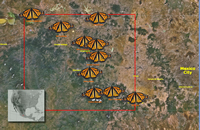The
Arrival in Mexico
By
Elizabeth Howard
writing from Angangueo, Mexico
November
18, 1997
 I'm writing this final migration update to you directly from Angangueo,
Mexico to confirm that the monarchs have indeed made it home for the winter!
I'm writing this final migration update to you directly from Angangueo,
Mexico to confirm that the monarchs have indeed made it home for the winter!
We drove here from Mexico City yesterday. After driving for 3 hours we began to see monarchs very suddenly, just east of Zitacuaro. First one, then another--and within a mile we drove into a blizzard of monarchs, all floating through the air like huge snowflakes.
The countryside here is scattered with daisy-like flowers (composites) which grow on huge bushes, often 8-10 feet tall. Many butterflies were drinking nectar from these flowers, fattening up before their long winter. Most, however, were in flight, drifting together in the same direction, continuing the silent parade that's been traveling toward this region since August.
 |
 |
 |
The long trip has clearly taken a toll on the monarchs. I was surprised to see how dull and faded their wings were, quite unlike the bright colors and fresh condition they had when we last saw them in the north. Though it was easier to see the butterflies that were flying low, it was most remarkable to look up in the sky and imagine their numbers. The butterflies filled a huge column of air and we traveled through them for over 30 miles. They were higher than the eye could see, and even with binoculars it was impossible to see how high the cloud of butterflies reached.
 |
As we drove into Angangueo monarchs were everywhere: flying past windows and over rooftops, past donkeys carrying loads of wood, past children dressed in red school uniforms, past men wearing the cowboy hats of Michoacan, past chickens in people's yards and houses painted with vivid colors. Against this backdrop of Mexican life were the same monarchs, so familiar in my garden at home, but now in an entirely different place. The atmosphere was lively and festive, and the butterflies decorated the sky as if for their own homecoming celebration.
 Up
in the Sierra Chincua sanctuary the size of the over-wintering colony
has grown substantially since biologist Eduardo Rendon watched the first
arrivals during the weekend of November 1 and 2. Where there were 2 trees
filled with monarchs on November 2, there are now 800 trees-- just 2 weeks
later! Already the forest floor beneath these butterfly trees is littered
with the wings of dead monarchs. The birds and mice that will prey on
the butterflies here all winter must welcome the arrival of this easy
source of food.
Up
in the Sierra Chincua sanctuary the size of the over-wintering colony
has grown substantially since biologist Eduardo Rendon watched the first
arrivals during the weekend of November 1 and 2. Where there were 2 trees
filled with monarchs on November 2, there are now 800 trees-- just 2 weeks
later! Already the forest floor beneath these butterfly trees is littered
with the wings of dead monarchs. The birds and mice that will prey on
the butterflies here all winter must welcome the arrival of this easy
source of food.
This week, as the butterflies continue to arrive and settle into the forest where they'll spend the winter, we're visiting schools in the surrounding region. Many of the symbolic monarchs you made are being given to the children here to watch over until spring. I'm taking as many pictures as I can, but I wish you could be here in person to see the excitement your butterflies bring. Each child carefully chooses one butterfly, then discovers where it came from and locates the home town of their new friend on a map. Though these children live right beside the monarch sanctuaries, they often don't know they are a world treasure. The Symbolic Migration is helping them to see the importance of their place, and to realize that children across North America know about them and care about the butterflies.
Elizabeth
Howard
Journey North







